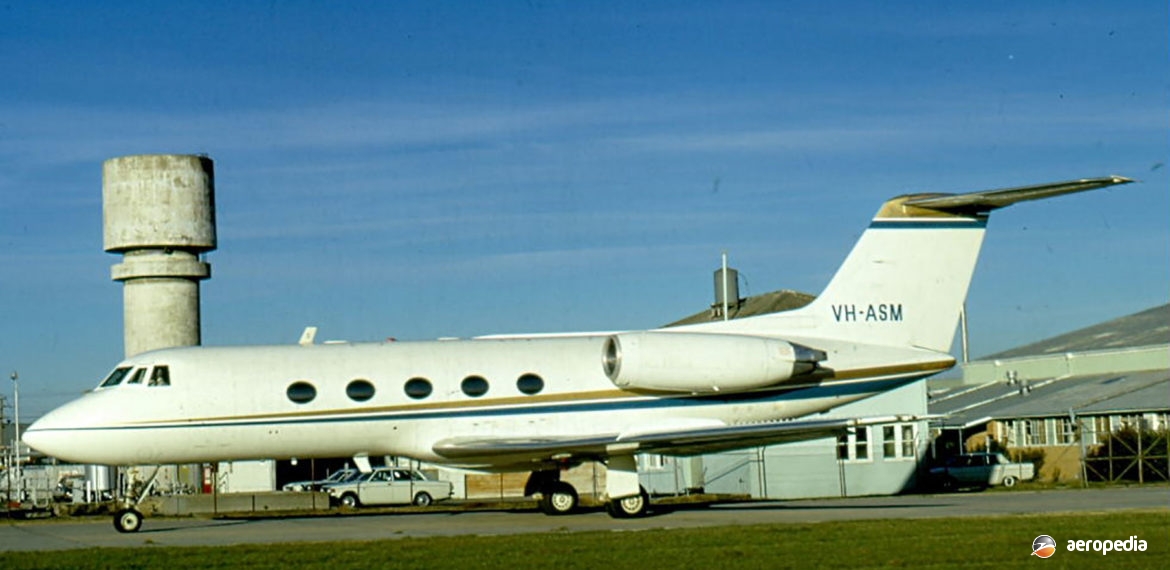Photograph:
Grumman Gulfstream II VH-ASM (c/n 91) at Essendon, VIC in June 1974 (David C Eyre)
Country of origin:
United States of America
Description:
Long-range business and executive aircraft
Power Plant:
Two 11,400 lbst Rolls Royce RB165-25 Spey Mk 51108 turbofans
Specifications:
- Wingspan: 23.7 m (77 ft 10 in)
- Length: 25.3 m (83 ft 1 in)
- Height: 7.4 m (24 ft 4½ in)
- Wing area: 86.8 m² (934.6 sq ft)
- Max cruising speed at 9,145 m (30,000 ft): 928 km/h (577 mph)
- Long range cruising speed at 13,106 m (43,000 ft): 825 km/h (513 mph)
- Max operational altitude: 13,716 m (45,000 ft)
- Range with 18 passengers: 6,327 km (3,930 miles)
- Max range with reserve: 7,699 km (4,785 miles)
- Empty weight: 17,374 kg (38,300 lb)
- Loaded weight: 30,963 kg (68,200 lb)
History:
In May 1965 Grumman Aerospace launched a successor to the Gulfstream I powered by Rolls Royce Spey turbofans, this becoming known as the Gulfstream II. Aimed at larger corporations which required a large executive aircraft with intercontinental capability, the Gulfstream II was quite successful, with 258 examples built, the last being delivered in December 1979. Based on the Gulfstream I, the II shared the forward fuselage and cross section but had 11,400 lbst Rolls Royce Spey Mk 511-8 turbofans, a new swept wing and T-tail, and seated ten.
No prototype as such was built, the first production aircraft (N801GA) flying on 2 October 1966. Very few modifications were made to the GulfstreamG II during its life. After aircraft 166, or those delivered after July 1975, ‘hush-kits’ were fitted to the engines to meet noise level requirements. During 1978 wingtip tanks were offered as an option, this providing an extra 1,415 kg (3,120 lb) of fuel.
In 1980 the Gulfstream III was introduced. The first aircraft N300GA (c/n 249 – later N901GA) was converted from G II configuration. Similar in design to the G II but with a supercritical wing, this model had the fuselage lengthened by 61 cm (2 ft) to improve the standard of comfort. NASA-style winglets were fitted, and standard fuel capacity was 16,276 litres (3,580 Imp gals). A total of 206 Gulfstream IIIs was built. In August 1978 American Jet Industries of Van Nuys, California acquired Grumman.
Primarily designed as a business transport seating eight, the G III has been used for a variety of purposes, including maritime surveillance with the Royal Danish Air Force as the SMA-3, being supplied in 1982. An optional cargo door was provided on the starboard side of the fuselage, and a cargo payload of 2,158 kg (4,758 lb) could be carried 6,411 km (3,984 miles) with IFR reserves. In the ambulance role it could carry five stretchers, three seated patients and three attendants. For operations such as airways checking, coastal surveillance, etc, an endurance of up to seven hours could be achieved.
Examples of most models in the series have been registered in this region over the years. Examples of the Gulfstream II have included VH-ASG (c/n 95 – ex N887GA) registered with Broken Hill Pty Ltd on 16 April 1971 and operated by Associated Airlines of Essendon, VIC. It was converted to G-1159B Gulfstream IIB configuration on 11 February 1986 and sold in the USA on 25 November 1993 as N427AC.
VH-ASM (c/n 91 – ex G-AYMI, N17586) was owned by Mines Transportation Pty Ltd (Conzinc Riotinto) and operated by Associated Airlines. It was exported to the USA on 20 February 1984 as N219GA
VH-HKR (c/n 69 – ex N45YP, N45Y, N45JM, N33CR, N25JM, N69NG) was registered on 29 March 1988 to the Hooker Corporation Ltd but only ever operated in the USA with that organisation. It was sold in the USA on 27 September 1989 as N21066.
A Gulfstream II was registered in New Guinea, this being P2-PNF (c/n 103 – ex N833GA, G-BDMF, N801GA, N855GA), which later became P2-PNG, which was exported in August 1984 as N833GA. It later became HZ-MSI.
One other Gulfstream II has operated in this region long term, this being N711SB (c/n 70), operated from 1987 to 1992 by PRL Aviation of Sydney,NSW.
Two G-1159C Gulfstream IIIs have operated in this region for extended periods, these being: N103GC (c/n 455 – ex N1SF, N335GA) which was operated from 1989 to 1995 by Trans Pacific Enterprises (News Corporation / Ansett Leasing) in Sydney; and N166WC (c/n 413) which was operated from about 1994 to 1999 by Jet Charter Services / Luft Aviation Charter / Premier Investments of Melbourne.
Examples of all models have visited this area over the years, particularly during the 2000 Olympic Games in Sydney.

